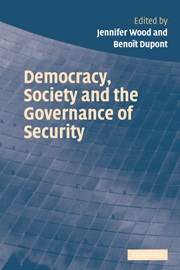Book contents
- Frontmatter
- Contents
- List of contributors
- Foreword
- Acknowledgements
- Introduction: Understanding the governance of security
- 1 Reflections on the refusal to acknowledge private governments
- 2 Transnational security governance
- 3 Two case studies of American anti-terrorism
- 4 Power struggles in the field of security: implications for democratic transformation
- 5 Policing and security as ‘club goods’: the new enclosures?
- 6 The state, the people and democratic policing: the case of South Africa
- 7 Necessary virtues: the legitimate place of the state in the production of security
- 8 From security to health
- 9 Research and innovation in the field of security: a nodal governance view
- Conclusion: The future of democracy
- References
- Index
9 - Research and innovation in the field of security: a nodal governance view
Published online by Cambridge University Press: 22 September 2009
- Frontmatter
- Contents
- List of contributors
- Foreword
- Acknowledgements
- Introduction: Understanding the governance of security
- 1 Reflections on the refusal to acknowledge private governments
- 2 Transnational security governance
- 3 Two case studies of American anti-terrorism
- 4 Power struggles in the field of security: implications for democratic transformation
- 5 Policing and security as ‘club goods’: the new enclosures?
- 6 The state, the people and democratic policing: the case of South Africa
- 7 Necessary virtues: the legitimate place of the state in the production of security
- 8 From security to health
- 9 Research and innovation in the field of security: a nodal governance view
- Conclusion: The future of democracy
- References
- Index
Summary
Introduction
There is much talk in the field of security, as in other fields of governance, of the need to design and implement innovations and to diffuse them from one context or site to another. Broadly speaking, an innovation is ‘an idea, practice, or object perceived as new by an individual or other unit of adoption’ (Rogers 1995: 35 cited in Nutley and Davies 2000: 35). New organizational approaches within and across a variety of fields have become marketable commodities in our global era. In the area of security governance there has been an ‘international trade in ways of understanding, and acting upon, more mundane, local, volume crimes’ (Stenson and Edwards 2004: 211) as exemplified in the widespread diffusion of ‘Compstat’-like programs across and beyond the United States (Weisburd et al. 2003). As well, models of ‘community policing’ are being marketed as service delivery ‘packages’ for improving crime prevention and enhancing public perceptions of safety (Wood and Font 2004).
The design and diffusion of innovations is, or should be, based on explanatory analyses of those sites wherein change or transformation is to take place combined with comprehensive assessments (instrumental and/or normative) of what exactly should be transformed and how. However, many scholars grapple with the question of whether, and to what extent, one can adequately describe and assess those sites that are to adopt innovations, particularly foreign locales characterized by unique social, political and cultural contexts (see Cohen 1982).
- Type
- Chapter
- Information
- Democracy, Society and the Governance of Security , pp. 217 - 240Publisher: Cambridge University PressPrint publication year: 2006
- 29
- Cited by



